March 26, 2015
By Rachel Rogol
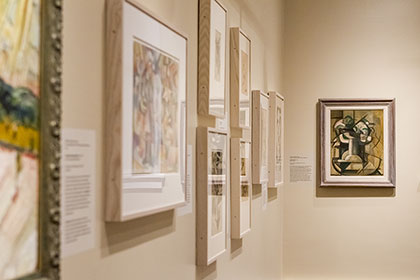
Some of the most influential Russian avant-garde artists of the early 20th century—Kandinsky, Rodchenko and Gabo, to name a few—are celebrated in a new exhibition at the Amherst Center for Russian Culture.
On view through June 26, КИНЕТИЧЕСКИЕ РИТМЫ: The Dynamic Spirit of Russian Modernism brings together works from the Mead Art Museum’s Thomas P. Whitney ’37 Collection of Russian Art and exemplifies the ways in which artists were able to break free from the prevalent realistic canon in the first three decades of the 20th century.
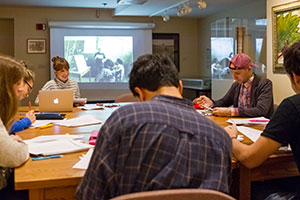
R.E. Keiter ’57 Postdoctoral Fellow and Visiting
Assistant Professor of Russian Art Michelle
Maydanchik teaches “Art/Politics in Russia”
in the Russian Center Art Gallery.
In summer 2014, Bettina Jungen, acting chief curator and Thomas P. Whitney ’37 curator of Russian art at the Mead, and Stanley J. Rabinowitz, professor of Russian and director of the Amherst Center for Russian Culture, oversaw the renovation of the Russian Center Art Gallery, a now newly refurbished space inside the Center.
Prior to 2014, says Jungen, the Center lacked adequate climate control and lighting conditions needed to safely exhibit works of art, and was open to visitors by appointment only. Jungen, with help from Mead Preparator Tim Gilfillan, addressed each of these needs. Now the Center can safely display oil paintings, sculptures, drawings, collages and prints. It’s also open to the public five days a week and available to Five College faculty for class visits.
Jungen considered more than 650 works by some 160 artists, which make up the art collection Whitney donated to the College in 2001, before making final selections for the exhibition. The collection is very diverse, says Jungen, and unique because Whitney didn’t necessarily aim to collect expensive works by big-name artists. “He wanted excellent works, but for a reasonable price,” Jungen explains, the result of which is a broad collection that, in addition to paintings, drawings and sculpture, includes illustrations for children’s books, stage and costume designs for ballet, opera and experimental theater and avant-garde mixed-media projects.
Whitney worked as a correspondent for The Associated Press in Moscow in the 1940s and 1950s. After returning to the States, he began collecting Russian books and manuscripts, which were relatively inexpensive, before turning his attention to art. (The Amherst Center for Russian Culture is home to nearly 15,000 books and is one of the largest repositories of Russian émigré poetry in the United States, collected by Whitney and given to the College in 1991.)
The Whitney art collection mainly comprises works by Russian émigré artists, which began populating the American market in the 1960s and were usually small in size, says Jungen. “Whitney had a good eye,” Jungen continues, in that he collected works that “represented a lot of artists and a lot of styles.” And he collected works by the same artists in different stages of their careers, revealing how their styles and influences changed over time. “He collected works before and after their heyday,” explains Jungen. “It’s interesting to be able to see these extensions of their careers.”
The exhibition ends in June when the Amherst Center for Russian Culture closes for the summer. Jungen will install a new exhibition of works from the Whitney Collection, featuring (non-avant-garde) landscapes, cityscapes and imaginary places, when the Center reopens in fall 2015.
Tour
Tour the Russian Center Art Gallery with Mead intern Darya Bor ’18 on Friday, April 10, at 12:30 p.m.
Hours
The Russian Center Art Gallery is open Monday, Wednesday and Thursday from 10 a.m. to 4:30 p.m., and Tuesday and Friday from 10 a.m. to 3:30 p.m. It is closed on weekends.
Class Visits
Faculty interested in scheduling class visits are encouraged to contact Bettina Jungen directly.
Further Reading: Curator’s Picks
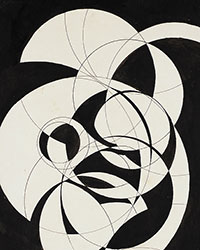
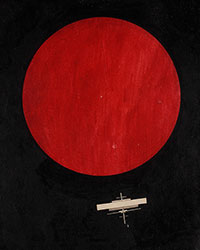
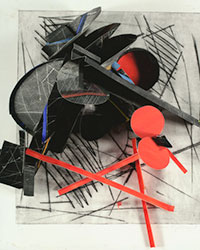
Three works included in the КИНЕТИЧЕСКИЕ РИТМЫ exhibition are Aleksandr Rodchenko’s Compass Composition, Il’ia Chashnik’s Red Circle and Suprematist Cross and Oleg Kudriashov’s Architectonic Project (details of each pictured above). Here, in Jungen’s own words, is her take:
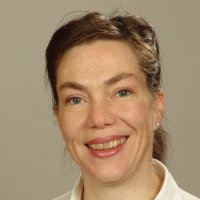
Bettina Jungen
“The combination of the three exemplifies in a compelling way the artistic relation between the avant-garde movements themselves and the unofficial art of the ’60 to ’80s in the Soviet Union.
Rodchenko was a Constructivist. In Compass Composition (pictured left), which belongs to his pre-Constructivism period, he explores the expressive possibilities of mechanically created lines and their relationship to flat areas of black. Creating a visually dynamic composition just with lines and color, not with narrative elements, was among the artist’s major interests in the mid-1910s.
Chashik belonged to the Suprematist group, which aimed at creating an alternative world in their paintings. While they also pursued the path of geometrical abstraction, they never constructed anything and were little interested in the material and structural qualities of lines and paint. It is obvious that Red Circle (pictured middle) alludes to a cosmic scenery. Yet, while Chashnik was interested in aviation, he did not illustrate his interest, but created a nonnarrative image evoking the vast universe.
Kudriashov is a contemporary artist. He created this architectural phantasy in Great Britain, where he has lived since 1974. Despite having been created outside of Russia, Architectonic Project (pictured right) refers to the Russian avant-garde, which was very influential for unofficial artists. With the red circular shapes, the graphic elements, the black surfaces and the architectonic structure, it refers to Constructivism and Suprematism, as well as to the early Soviet tradition of building monuments and towers, which are shown at the beginning of the exhibition.”